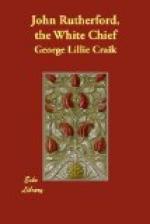“One of them informed us that there was a white man in his party who had heard of and wished to see me; and that the chiefs, who also wished to see me, would give me permission to cross the river to meet him, and I should return unmolested whenever I thought proper. With Aimy’s consent, therefore, I went across the river; but I was not permitted to go armed, nor yet to take my wife with me. When I arrived on the opposite side, several of the chiefs saluted me in the usual manner by touching my nose with theirs; and I afterwards was seated in the midst of them by the side of the white man, who told me his name was John Mawman, that he was a native of Port Jackson, and that he had run away from the ‘Tees’ sloop of war while she lay at this island. He had since joined the natives, and was now living with a chief named Rawmatty;[BZ] whose daughter he had married, and whose residence was at a place called Sukyanna,[CA] on the west coast, within fifty miles of the Bay of Islands. He said that he had been at the Bay of Islands a short time before, and had seen several of the English missionaries. He also said that he had heard that the natives had lately taken a vessel at a place called Wangalore, which they had plundered and then turned adrift; but that the crew had escaped in their boats and put to sea. This is the same place where the crew of the ship ‘Boyd’ were murdered some years before.[CB]
“While I remained among these people, a slave was brought up before one of the chiefs, who immediately arose from the ground, and struck him with his mery and killed him. This mery was different from any of the rest, being made of steel. The heart was taken out of the slave as soon as he had fallen, and instantly devoured by the chief who slew him. I then inquired who this chief was, and was informed that his name was Shungie, one of the two chiefs who had been at England, and had been presented to many of the nobility there, from whom he received many valuable presents; among others, a double-barrelled gun and a suit of armour, which he has since worn in many battles. His reason, they told me, for killing the slave, who was one belonging to himself, was that he had stolen the suit of armour, and was running away with it to the enemy, when he was taken prisoner by a party stationed on the outskirts of the encampment. This was the only act of theft which I ever saw punished in New Zealand.
“Although Shungie has been two years among Europeans, I still consider him to be one of the most ferocious cannibals in his native country. He protects the missionaries who live on his ground entirely for the sake of what he can get from them.
“I now returned to my own party. Early the next morning the enemy retreated to a distance of about two miles from the river; upon observing which our party immediately threw off their mats, and got under arms. The two parties had altogether about two thousand muskets among them, chiefly purchased from the English and American South Sea ships which touch at the island. We now crossed the river; and, having arrived on the opposite side, I took my station on a rising ground, about a quarter of a mile distant from where our party halted, so that I had a full view of the engagement.




